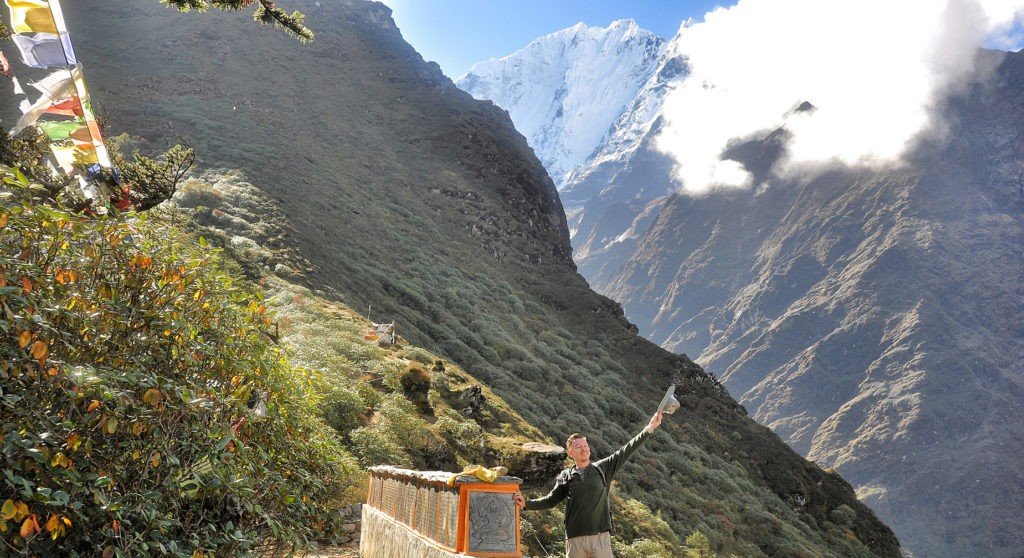You can trek in the Everest region during every season, just like you can in all of Nepal. Hard to believe, right? Well, you have to accept it because it’s true. Everest Base Camp Trek is an exclusive chance that tops the bucket list of adventurers worldwide. Travelers choose spring and autumn as the perfect seasons for the Everest Base Camp Trek. But not everyone knows that you can also trek in the summer and monsoon as well. It is said that no bad weather is bad weather in the mountains, and it’s true.

There’s a quote by a famous British explorer, Sir Ranulph: “There is no such thing as bad weather, only inappropriate clothing.” Trekking in the Everest during the summer and monsoon is the perfect example. The beauty of the Khumbu region is absolutely exceptional during the summer. You wouldn’t have the slightest clue that this rugged terrain could get so verdant and green until you witness it yourself. While canceled or delayed Lukla flights might test your patience, the entire Everest region will blossom vibrantly to address your presence in the season.
The months from June to August mark the summer season, with monsoons starting mid-June. These months are usually considered off-season, but for adventurers, the season has its own charm. If comfort was to be side-eyed, Everest Base Camp Trek during summer and monsoon is much more than expected. Everest, being in the trans-Himalayan region, is much less affected by the monsoon. The trails, though not the driest, are still walkable and mud-free. Don’t expect the peaks to shine at you for the Mountain View the whole time. But once the cloud clears up, the views will be like nothing you’ve seen.
Here are some of the reasons why you should go on an Everest Base Camp Trek during the Summer/Monsoon:
Stunning and Tranquil trails

The Everest region doesn’t attract many travelers and trekkers during the summer/monsoon, as it is considered “bad weather conditions.” Most people travel in spring and autumn when the weather is mild and almost perfect. So, you’ll have the trail all to yourself and can trek in peace. If you’re wondering whether the trails will be muddy, we assure you they won’t.
For the view, it’s not as bad as people fear, as the mountains may surprise you by peeking from behind the clouds. Furthermore, you’ll be free to enjoy the best hospitality at the best establishments. The serenity is just a godsend along with the season. Because of the empty trails, you can explore more intricately around the Everest region.
Grass-covered and lush landscapes

During summer, the alpine vegetation of the Khumbu region is at its best. The land, otherwise barren, gets covered with greeneries during this time of year. The colorful bloom of the rhododendrons paints the forest into art, with white, pink, and red colors. All along the way, you’ll hear birds chirping and see yaks grazing peacefully in the meadows.
The rain-nourished mountainous surroundings offer spectacular and fresh natural beauty. So, Everest Base Camp trekking during the monsoon season is a unique experience for Himalayan prospects. It is filled with lush greenery, colorful blossoms, and landscapes washed and shaped by rainfall.
Mild and moderate temperatures

The best part of trekking during the summer or monsoon is that you’ll have a moderate temperature. The temperature during the day doesn’t exceed 25 degrees, even when the sun is high. At an altitude of more than 4000 meters, the temperature during night/morning will drop to as low as negative 10 degrees.
Usually, it rains a little below 3500 meters, occasionally over 4000 meters. It’s not like the monsoon you thought about, right? These are the perks of being in the Trans-Himalayan region. The temperature is perfect for trekking.
The stunning sights of the Himalayas

Although clouds cover the mountain peaks most of the time, a gust of wind can clear them, revealing the majestic mountains. The sight of the mountains among the patches of cloud is unreal. Usually, the morning is clear, with a higher chance of admiring the sunrise on top of the mountains. Even if the day becomes gloomy, you’ll still have an amazing trekking experience.
As impressive as monsoon trekking is, there are things you need to be careful about. Lukla flights have a tendency to get delayed and canceled often during the rainy season. So, having a few buffer days in your trip schedule is necessary. Well, the climate is busy the way it should be. Take a few simple cautions, and the monsoon trek is worth it.
Tips for Everest Base Camp Trek during Summer/Monsoon
Stay Hydrated
Water is crucial to regulate body temperature and maintain oxygen levels. You'll need to stay well hydrated for the proper functioning of the mind and body. Hydration is also vital to avoid physical weakness, such as fatigue, muscle cramps, dizziness, etc.
During your trekking journey, you’ll experience excessive physical work. Your body will sweat a lot, so you should drink water. Drink at least 3 to 4 liters daily to avoid dehydration and ensure optimal functionality. You can carry a thermal water bottle and use water purification drops or tablets for safe drinking water.
Hydration also prevents altitude sickness, a risk factor in high-altitude trekking adventures. During the Monsoon, with the increased humidity in the air, you may not feel thirst as you would in drier conditions. Without knowing, you may be susceptible to the possibility of altitude sickness. So, staying hydrated is crucial, allowing you to adjust to the low oxygen levels of higher altitudes and avoid potential sickness.
Keep Weather Updates
Unstable weather conditions occur during summer or monsoon. You may have to stop trekking and wait until the weather improves. So, while planning the Everest Base Camp Trek in summer or monsoon, it is wise to check the weather forecast to avoid possible hassles and ensure safety during the journey.
The frequent changes in weather during the Monsoon season can hamper the trek. That’s why you must keep regular updates on the weather conditions while on the journey. Also, be mindful of any alerts issued by local authorities or trekking agencies. Such warnings help you make informed decisions regarding your trekking activities.
Pack Appropriate Trekking Gear
You must be well-equipped with proper trekking gear for a comfortable and successful trekking journey at Everest Base Camp during the Monsoon season. Ensure you carry the appropriate equipment that can be handy in wet and muddy conditions. Here are some essential things you must pack for the Monsoon/Summer trekking.
- Water and windproof jacket
- Rain pants
- Rain cover for backpack
- Waterproof trekking boots with good grip
- Gaiters (keep your feet dry by preventing the slip of water)
- Quick-drying clothing
- Waterproof hats and gloves
- Sunglasses
- Toiletries
- Towels
Extra Days in Case of Bad Weather
Clouds and fog are expected during the Monsoon season, which can reduce environmental visibility. With a faint vision, you cannot proceed safely and efficiently on trails, which makes trekking more complicated. Also, you must take frequent breaks to wait for the weather to clear and enjoy the scenery. Due to recurrent rain, the trekking trails are often muddy and slippery. You must take extra precautions to walk on wet trails or avoid walking to prevent accidents.
With its unstable and rainy weather conditions, Monsoon sometimes takes a day to improve the weather. In such situations, you may have to extend your trek or stop for a few days to continue on the trekking journey. So, you must include the extra days into your trek plan to allow for possible delays due to unfavorable Monsoon weather. Also, be updated about the trail conditions before embarking on a trek in Monsoon.
Pro’s and Con’s of trekking to the Everest Base Camp during Summer and Monsoon
Trekking in the Everest region during these seasons offers quite an experience but has pros and cons. Let’s look at some of them:
Pros of trekking during summer and monsoon
- Lush greenery: During the summer and monsoon, the region is filled with lush green vegetation, turning the landscape colorful. The mountainside and valleys are covered with wildflowers and offer stunning sceneries.
- Fewer crowds: This season, there are fewer trekkers on the trails, which means that you’ll have a peaceful and discreet trekking experience.
- Cultural experiences: The monsoon and summer season coincides with various festivals of the Sherpa community. Trekking during this time will let you witness the ceremonies and festivities.
- Lower costs: Since this is considered an off-season for trekking, you may get low prices for accommodation, flights, and permits. This will eventually make the cost of trekking more affordable.
Cons of trekking during summer and monsoon
- Rain and mud: The monsoon season brings heavy rainfall to the Everest region, resulting in muddy and slippery trails. Trekking in such conditions can be challenging and increases the risk of slips and falls. Continuous rain may also limit visibility and obstruct scenic views.
- Landslides and avalanches: The increased rainfall during the monsoon season can trigger landslides and avalanches in the mountainous terrain. This poses potential hazards to trekkers, especially in areas prone to natural disasters.
- Flight delays and cancellations: Weather situations during the monsoon season can lead to frequent flight delays and cancellations, particularly for flights between Kathmandu and Lukla. This doubt can disrupt your travel plans and itinerary.
- Risk of leeches and insects: During the monsoon season, damp and moist conditions create satisfactory habitats for leeches and insects along the trekking trails. Trekkers need to take precautions to prevent bites and infections.
Everest Base Camp Trek in summer Itinerary 2025 - Best Summer Trek in Everest
FAQs regarding EBC Summer Trek
Can you hike to Everest Base Camp in the summer?
Yes, it is entirely possible to hike to Everest Base Camp during the summer months, specifically June through August. While achievable, it is generally not considered the most ideal time, as this period coincides with the monsoon season. Trekkers can expect heavy rainfall, which typically results in muddy trails and often limited visibility of the majestic Himalayan peaks. Despite these conditions, the trails are notably less crowded, and the lower altitudes flourish with verdant landscapes, requiring well-prepared waterproof gear and a flexible schedule, especially concerning travel to Lukla.
What is the weather like in Everest Base Camp in the summer?
During the summer months, specifically from June through August, the weather at Everest Base Camp and along the trek route is largely defined by the monsoon season.
While lower altitudes experience heavy and frequent rainfall, leading to lush, verdant landscapes and potentially muddy trails, conditions higher up, including at Everest Base Camp itself (5,364 meters), are different. Temperatures at EBC can still be quite cold, typically hovering around freezing point, and can drop well below at night, even with daytime averages often around 5-10 degrees Celsius. However, the most significant characteristic is the prevalence of clouds and fog. These conditions frequently obscure the iconic panoramic views of Everest and the surrounding peaks, leading to limited visibility. Snowfall is also possible at such high elevations, even during what is considered summer. The air tends to be highly humid throughout the entire region during this period.
Conclusion
Trekking to Everest Base Camp during summer and monsoon can be rewarding for those seeking unique experiences. However, being well-equipped, physically prepared, and mindful of safety considerations is essential when going on such an adventure during this time of the year.



